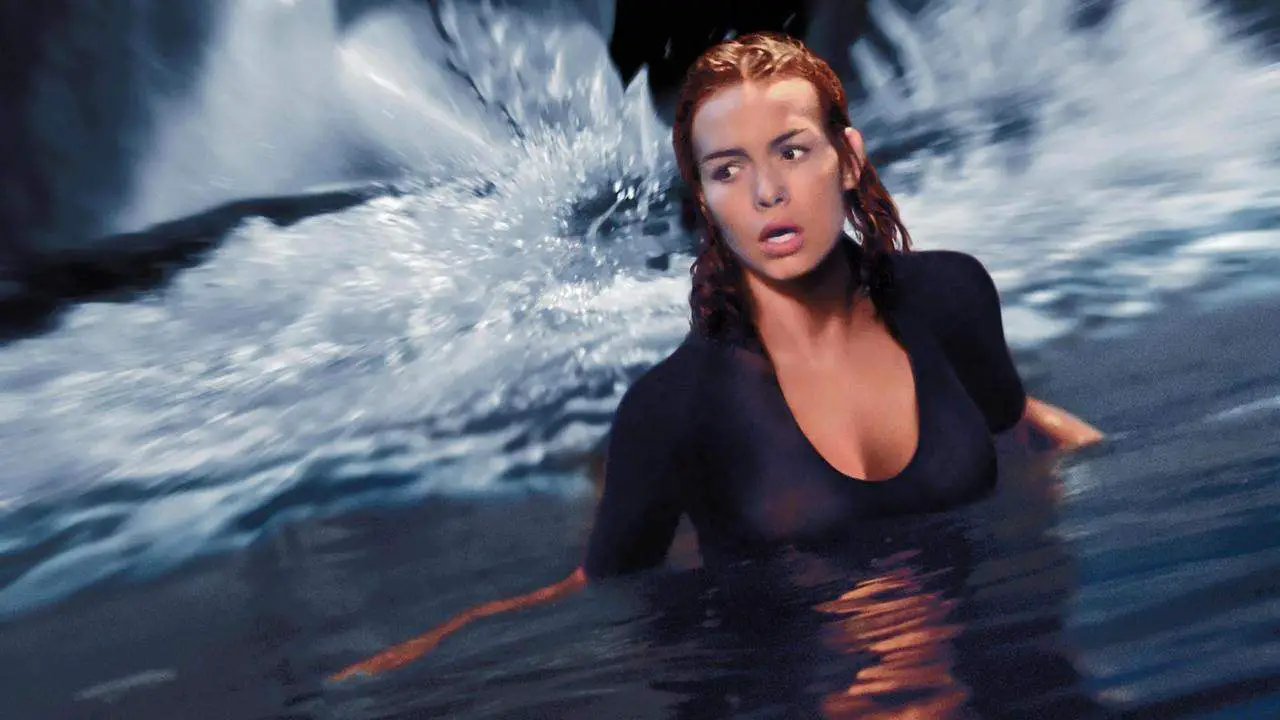There are many different types of killers in horror films. They can be a deranged stalker, a supernatural presence, or even a hungry shark. The latter is what Alicia Silverstone (The Crush) and James Tupper (Big Little Lies) are up against in Saban Films’ new shark attack survival pic, The Requin. The synopsis reads: There’s terror in paradise when Jaelyn (Silverstone) and Kyle (Tupper) arrive at a remote seaside villa in Vietnam for a romantic getaway. A torrential storm descends, reducing the villa to little more than a raft and sweeping the young couple out to sea. Suddenly, another danger appears: a school of great white sharks. With her injured husband watching helplessly, Jaelyn must battle the deadly predators alone in this tense thriller that rides an unrelenting wave of fear.
We had the opportunity to speak exclusively with the film’s cinematographer, Matt S. Bell (Santa Jaws), about how The Requin came together. Below he shines a spotlight on the bloody waters of The Requin.
Wicked Horror: Did any of the shots you had planned for, have to be altered on the spot when filming started? If so, can you talk about which ones?
Matt S. Bell: We had big plans for this animatronic shark that we were going to use in the water that was full scale. It was bloody and had bruises from the battle it had been in at that point. Ultimately, we had to move that shark to dry land because the way it was constructed in the short amount of time that the art team was given. As amazing as it looked, it was so hard to move in the water. We pivoted to as practical as possible, to doing it on green screen, on dry land with the intent of digitally inserting the shot of that shark into a VFX landscape. We kinda saw that coming to be honest. I have done 4 or 5 of these shark movies and the second you make anything out of foam, it floats like a boat. At the end of the day, the shark looked very cool. That was a big one. Kiet was really diligent, making sure we had story boards for all the major action sequences and big stunt sequences. For the most part, we had the movie edited before we got to shooting, which was very helpful.
WH: How long did it take to film The Requin?
Matt S. Bell: From beginning to end, I got the script and the initial call for interest a month before I was hired. A month after that, I had a two-hour phone conversation with Kiet and we talked about everything from different style choices, to character motivations and the look of the film. We spoke a long time about that and then almost immediately I got hired. Once that call was made, I was in my RV (I’m a traveling DP) and in Orlando the next day. It was three or four weeks of prep on location and I think we shot for 20 days. All in, it was under two months for me.

WH: How much of the film was shot on a soundstage? How did you keep the lighting consistent throughout?
Matt S. Bell: That is the big question. Lighting consistency is a big thing regardless of stage or not stage. You put together a template or reference book, everyone has a different name for it. I certainly had mine. As far as how much was shot on stage, all of the villa interiors were shot on stage. As well as the storm sequence. As well as Alicia’s flashback material. Besides that, everything was between Cabana Bay, the Universal Cabana Bay in Orlando. As well as all the water work. Once Alicia and James’ characters are at sea, we shot all of that at a private, Olympic size pool in a state park in Orlando.
So maybe 20% of the movie is on stage and the rest was practical locations. A dry, hydraulic set on stage would have been ideal, but that wasn’t in our cards unfortunately. Luckily the villa interiors were pretty easy to control. Most of exteriors were done with exterior light, whether it be on green screen or a little more practical pool work. It wasn’t too difficult to work with the elements and keep things looking consistent.

WH: The opening scene shows the two main characters outside their hut, only lit by moonlight. What is the key to making “moonlight” look normal against human bodies?
Matt S. Bell: Moonlight is one of the singular most subjective lighting sources I can imagine. I have heard other directors and other DPs talk about this. How people deal with moonlight just spans the whole gamma of lighting techniques. Some people go for hard moonlight. Some choose different colors. They do tungsten bulbs bouncing off of silver and then add a little green to it. Or maybe add a little blue to it. There is a whole gamma of options when it comes to adding moonlight. For me, it’s just what’s most natural. Whatever feels right for the production design. If you can get away with it being more available sources, like street lights nearby or lights comes off of the villa. That scene is lit primarily with rising sunlight, so it’s blue hour, on when it takes place in the film. Making moonlight look natural is one of the tougher things that every DP has to figure out, because it never feels natural or real, but you can certainly hide it in the world of whatever the film is by treating the moonlight whatever makes most since with the color palette. It doesn’t always have to be a big bright blue source. It’s like a chef making a perfect scrambled egg, there are many ways. If you get a call for a night shoot, that’s always one of the first questions, how do you plan on making moonlight. If you can do moonlight, you can do anything.
WH: Can you talk about some of the underwater shots, since there are a lot of them. How did your camera and camera work differ for those shots, as opposed to the land or dry shots?
Matt S. Bell: For most of the true underwater sequences we brought in a friend of mine, Richard Ball, who is a true underwater certified operator. We used another camera system for those shots. It was a Sony camera inside of an underwater housing. Full scuba gear and all that. We also used a splash bag system for the Alexa mini LF in our A camera setup, for anything that was surface of the water. So any time the camera does any sort of surface level things, that was all Alexa.
WH: Can you talk about Alicia’s flashback sequences? How was your approach to those different than the rest of the film?
Matt S. Bell: That was a pretty interesting situation because out of the film overall, those stood out the most as a standalone venture, visually. It was always going to play as flashback material, just like it does in the film. So Kiet and I were prepared to make that look more dreamy and surreal. We opted for this one wall set that falls off into darkness. Very high contrast and emotional. We treated that as its own separate look. Shooting wise, that was another element that we shot onstage. It was a very intimate moment for Alicia. Not to speak for her, but having gone through child birth, she really wanted to nail that one and took a lot of sensitivity with that scene. We ended up using a 90-degree barrel mount for the Alexa LF full body for that shot. That 90-degree angle barrel allowed me to put the lens as close to the water as possible, being that we were shooting in a practical, ceramic tub that was giving us a limited amount of space for what Kiet wanted out of the shot. So I ended up getting the 90-degree barrel mount that extended the lens, so instead of putting the camera in entire tub, it was now just the length of the tub, which gave us a lot more room to do this push-in loop we wanted to get.
Also See: Five Great Movies Directed by Make-Up Artists

Matt S. Bell
WH: A lot of CGI was used in The Requin. I imagine, cinematography wise, that a CGI heavy project is much more difficult to shoot, because you aren’t always seeing what’s right in front of the camera, in present time. Is that true? Have you studied CGI cinematography before?
Matt S. Bell: The CGI aspect definitely affects what we are doing as cinematographers and what everyone is doing in their individual positions on set. In a best case scenario, we would have elements of what the final shark is going to look like and what can we expect from this sequence. That will dictate how we shoot it. That stuff has to match pretty closely or else the shot falls apart. Generally speaking, it is a very vicarious shooting style, but working with the VFX supervisor, artists and lighting crew to make sure we are shooting things that helps out the VFX at the end of the day. Where The Requin was special, being that we were shooting at the height of Covid, there was a big push to get as few people as possible on set. One of the thoughts we had was to have the VFX team stay remote, being that they were already located in Vietnam. We opted to do a live feed through my DIT, to give the VFX team a live picture, while we were shooting it. We did our best to take as much time for the VFX people to give their suggestions on what to change. The same process, but more cumbersome because the wire was in the way.
It was definitely more tough. My experience with CGI heavy water movies, really came into play, because there was a lot of moments when we just couldn’t hold that connection and there are decisions that have to be made on set. In terms of my specific schooling with CGI work, I have done a fair amount over various films, the obvious being the shark movies. A lot is experience and using common sense and what looks right. At the end of the day, we are there to make it as efficient as possible for the post team to do the background placements they need to do or fix any sort of color bleed that might be in the picture. You try to eradicate all those problems ahead of time.
WH: Did you go back and watch any shark horror classics like Jaws or Deep Blue Sea before beginning work on The Requin to get inspiration?
Matt S. Bell: Absolutely. We watched Jaws, The Reef of course Deep Blue Sea. We watched other movies, Kiet is a very character driven director. Not to speak for him, but he was most interested in the two lead character’s relationship there. Being stranded at sea was more a marriage obstacle then an actual, physical obstacle. That’s what he gravitates towards more. Which is great because it lends the other collaborators a sense of freedom to bring the rest of the shark element and stranded at sea element. Just the way we were going to treat some of these scenes to play as continuous as possible. We did a lot of one take oners because we knew VFX would replace the background. We were able to do a lot of fun stuff like that. Kiet did a really good job of dictating the overall vision and then letting everyone else fill in the blanks, which is a very fun way to work.







